 Facebook
Facebook
 X
X
 Instagram
Instagram
 TikTok
TikTok
 Youtube
Youtube
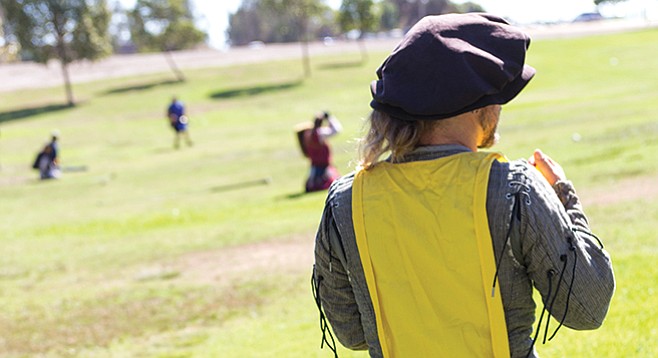
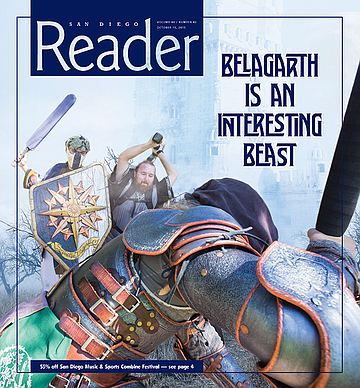
Morley Field is alive with activity on Sunday afternoons. A casual observer can find tennis matches, baseball games, kickball practices, and cyclists speeding around the velodrome — all typical activities one would expect to find in a city park circa 2015.
On the other hand, if this curious person were to head toward the northern edge of the frisbee golf course (near the intersection where Arnold Avenue meets Jacaranda Place) he would run across something seemingly out of place — a medieval battle in the midst of North Park.
Andor is a realm within the larger “medieval combat society” of Belegarth. The name “Andor” specifically relates to the geographic location of Morley Field. Anyone who participates in Belegarth is welcome to fight at the weekly practices on Sunday afternoons.
At first glance, Andor appears to be hardcore Game of Thrones, Lord of the Rings, and Dungeons and Dragons fanatics duking it out on a hot day with, primarily, foam swords. Upon closer inspection, the group is more akin to medieval knights on a budget. Clothes are period-specific, and, for the most part, ragged and cheap. The look of tougher times is evident. A man playing the role of a down-on-his-luck serf is visible just east of the battlefield, rummaging through a trash receptacle in search of valuable glass bottles.
(Oops, that’s a local homeless gentleman.)
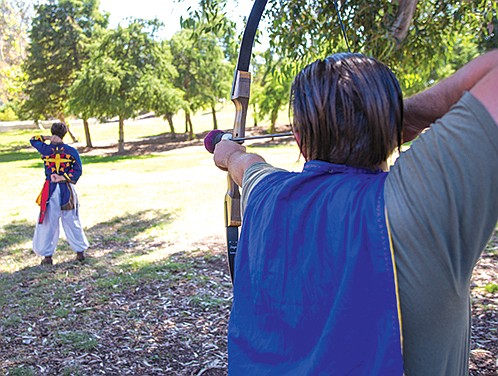
Coincidentally, this is the perfect opportunity to bring up the fact that, unlike the LARP movement (Live Action Role Play), Belegarth is firmly rooted in combat. There are elements of LARPing in the clothes the participants choose to wear, but the activity is all about the sport. If LARPing could be considered a fantasy board game done with real-life acting, Belegarth is more akin to paintball with swords instead of guns. The battles are chaotic and — I pledge my troth — intriguing. Random spectators gather round the group, and many sign a waiver, grab a sword, and take their own stab at combat.
I first met Amilio Aviles while I was attending a birthday party across the street from the imaginary medieval battlefield. He approached our group and started pitching Belegarth to the partygoers. Serving as a sort of ambassador for foam shields, torn scrubs, and swords that would have a tough time with butter, Aviles walked us through the ins and outs of Belegarth. He was an apt salesman and a cordial knight. He even let us hold his sword. Of course, there would be no swinging of swords until waivers were signed. The look may be Camelot, but the era we live in is “sues-a-lot.”
Belegarth participants adopt fighting names. Aviles’s Belegarth name is Outis. I liked him from the get-go. He is passionate about his sport and has a delightfully carefree attitude about not giving a poo about what people think about him parading around the park looking like a lost extra from Monty Python and the Holy Grail. Outis serves as “field commander” for Andor. It is one of the two official elected positions in the realm. He explained his main responsibility as “making sure things on the field run properly.” Or, in other words, “I make sure that we’re not just sitting around not fighting. Somebody has to make sure we fight.”
The latter observation seems to ring true. When I met up with Outis on a Sunday afternoon a couple of weeks after the birthday party, I was lucky to catch him at the same time that an enchanted chariot from some future civilization had pulled up to refuel the participants with frozen sweet treats.
“Ice cream is here, we have some time,” he said.
Perhaps there is some lost text involving the knights of King Arthur’s court pausing a battle to indulge in a feast of Chaco-Tacos. More likely, the group members enjoy sitting around and shooting the metaphorical shit just as much as they relish the perfect strike of a foam sword to the flesh. It makes sense that a fight motivator could actually benefit this collection.
Outis’s post as field commander effectively makes him the vice president of the group. The main elected position, the ark-herald, adopts the traditional role of the president. His duty, according to Outis, is to “make sure everything runs smoothly off the field. They make sure the weapons come out. They make sure that if there’s any disagreements or questions that it always comes back to the ark-herald to make a final executive decision. They are in charge of making sure that we participate in the national votes. There’s a national organization of Belegarth, and we are a voting realm of that. Every quarter there are some votes, like if you want to change the rules or if they want to admit new groups, that kind of thing and it’s the ark-herald’s responsibility to make sure we take a vote locally and then say what our vote is on the national forms.”
On the national front, Belegarth is an interesting beast. It officially began in 2001 as a splinter group from a similar organization called Dagorhir. According to its website, Belegarth is a medieval combat society that “is a safe, inexpensive, and fun sport where participants wear medieval or fantasy themed clothing and fight with foam padded weapons. The fighting is hard and fast and has since 1979 refined into its own brand of martial art. The rules are easy to learn and after a few practices you will be hooked.”
The synopsis continued: “Most groups are based on Tolkien’s Middle Earth; but they don’t limit themselves in any way, you choose the character you are inspired to portray. You could be a religious knight fighting behind a shield with his trusty sword, a savage Viking raider charging into battle with your mighty axe in hand, a noble elf standing tall quickly firing arrows, or even a foul goblin crawling on the ground sneaking to get that quick unseen back stab. The choice is yours!”
At the moment, there are 21 realms in California. Illinois has the highest count in the United States with 27. The closest realm to Andor is Blackwater in Chula Vista. Besides being a collection of individuals with impressive fighting skills, the realm has no direct connection to the contracted security firm of the same name that garnered headlines during the Iraq War.
One member of the collection who splits his time between the realms of Andor and Blackwater is a 25-year-old tutor from Chula Vista who fights under the moniker of “Aizen.” Clad in impressively tailored battle garb rooted in purple, Aizen is one of the eldest members of the Andor realm.
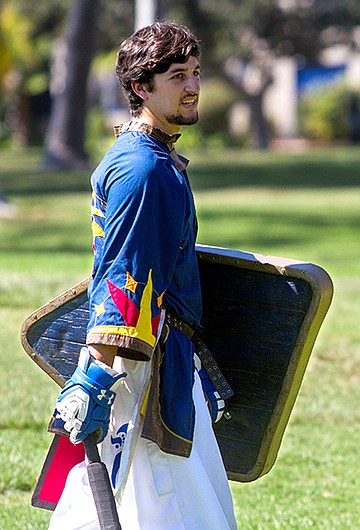
“When I was 14, I was in high school and a couple of my friends found the website online,” Aizen explained. “We would be outside in the woodshop using wooden sticks to hit each other and fight when we were younger. It wasn’t safe, but we had a lot of fun doing it. When they told me that there was an organization where we could come out and do this I was, like, ‘Yes, I want to do that!’ That was 11 years ago.”
As a participant since 2004, Aizen even predates the current field commander, Outis, at Andor. He gave a brief history of the beginnings of the realm.
“The story kind of goes that the person that started this group was named Orion,” he explained. “He and his wife (Xooyan) stuck around for two years. They came and brought all the weapons, taught all of us how to sew and make everything. Then they had a baby and they moved to Arizona and bought a house out there. They tried the best they could to raise leadership…but a lot of us were 16,” Aizen laughs. Honestly, there were only about three people in college at that point of time. Cars were a big commodity.”
At first, Andor was comprised almost entirely of high school kids. After the original founders left and the kids got older, moved away, or just lost interest in the fighting, the realm fell on hard times. It was during this era that Outis entered the picture.
“A lot of that original group left,” Outis recalled. “We were lucky to get five or six people out. I actually happened to be the leader during a lot of those times, and it was just as much as I could do to keep the group going. When you have 20 people, more people show up all the time. More people want to try it, the group is very lively. When you’re down to five, if one person doesn’t show up, you can’t really fight with just four people. It’s just sparring and then everybody gets bored and goes home. You really gotta have at least six people in order to have a three-on-three fight.”
According to Outis, 2007–2008 were the true “dark times” for the realm of Andor. Their luck changed soon after that, when Blackwater began in Chula Vista. The new realm had fighters who would split their time practicing with the two groups.
“Suddenly we had an extra five or six people,” Outis said. “So, if you have your regular five or six and suddenly another five or six, you’ve got a dozen people every Sunday pretty reliably. Once you’ve got a dozen people out there, suddenly everyone wants to stop in and try it. You start getting a new person every week or two because everybody wants to bring a friend or somebody walks up and wants to try it. Once you have a critical mass, more people just come.”
Although new recruits arrive in many fashions, the most reliable seems to be ye olde “friend of friends” method. I chatted for a bit with Alex Krochman, a 24-year-old student who also works part-time as a bookkeeper for a CPA firm. In the realm of Andor, Krochman is known as “Tordek the Dwarf.”
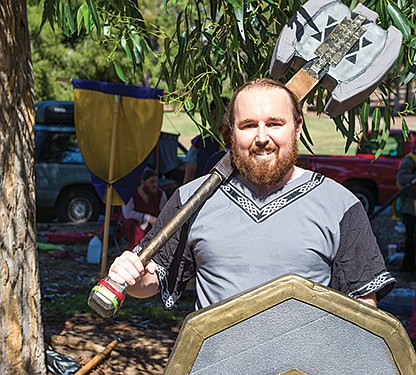
“I live in an apartment complex that now has five separate units that are all fighters,” Tordek the Dwarf explained. “Most of the guys in my complex weren’t fighting when they moved in. I’ve brought them out to the sport and they’ve decided they love it. More fighters have moved into the complex as it has grown in...notoriety, I guess would be the word. We’re pretty well known around the sport in this area now. People come out and hang out with us all the time. We do build days and work on projects together. We have a nice little community going.”
He concluded, “Anyone that I’ve gotten out to the field and put a sword in their hand, with the exception of maybe one or two people who just clearly came out just to humor themselves, have all decided it’s awesome.”
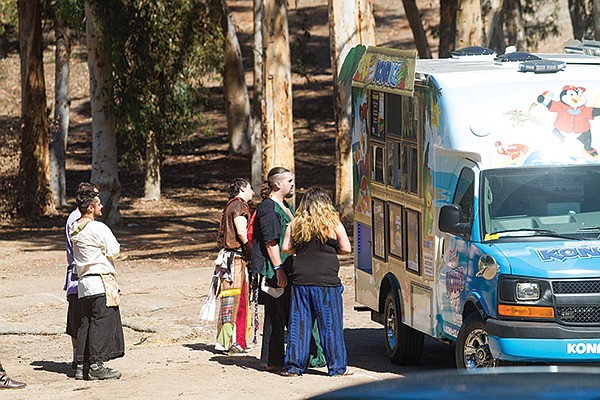
The cruel reality for Andor is that the random Morley Fielders who casually try the sport don’t tend to stick around.
“We ask if they want to try it and then some people stop and try it,” Outis said. “Of the number of people I invite, I would say maybe 10 percent say ‘sure’ and give it a try. Of the people who try it one day, maybe 1 percent of them end up coming back another time. But, you know, eventually you get some people. We do have quite a few people who just walked up one day and stuck around.”
A new method that Andor has instituted to draw attention (and perhaps some new recruits) to their realm is participating in the annual North Park Toyland Parade.
“That’s something that I started a few years ago because I figured that we’ve been in North Park for over a decade and that we should be an active member of the community,” Outis explained. “We, as a group, will go in the parade and fight the entire length of it. It is the most exhausting event we ever do. It may seem like a nice, gentle walk, but when you’re running and swinging at each other for a straight hour, it’s utterly exhausting. Honestly, that’s not so effective for recruitment; it’s just to get public acknowledgment so people know we’re not these crazy, dangerous people in the park hitting each other.”
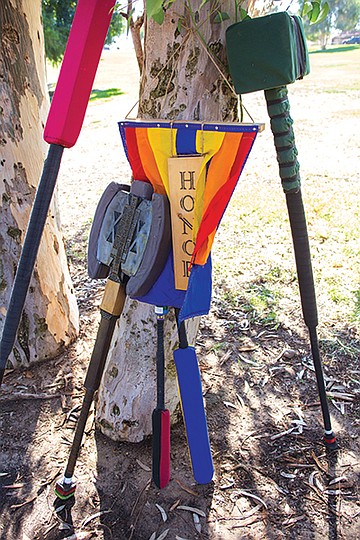
In order to hit one another in a crazy fashion, the fighters in Belegarth utilize five classes of weapons. Class One are swung, one-handed weapons. These are your axes, swords, hammers, and clubs. Class Two are called “red weapons” and are, basically, larger (over four feet in length) swung weapons that generally have to be held with two hands. Class Three weapons are stab weapons. You can’t hit an opponent with a broad swing utilizing a stab weapon, you can only, as the name implies, stab them. Also of note is the fact that stabs can only be registered to the chest. Moving on, Class Four are projectile weapons. The most popular projectile seems to be the javelin, which are basically heavily padded spears. Bows and arrows fall into this category as well. The final option, Class Five, is perhaps the simplest weapon of them all: rocks.
“They look like pillows because they’re basically pillows,” Outis explained. “They are thrown only and headshot only. If I throw a rock and it hits you in the head, you’re dead. If I hit you anywhere else, it’s nothing because it’s just a rock.”
“Please tell me there are catapults?” I interrupt.
“People have tried to build catapults,” Outis explained. “There is nothing in the rules that govern how they work, so whenever you make one, you have to come up with what the local group is going to do to use it. Generally they don’t work in small groups because it’s pretty easy to dodge a catapult when there’s only about five people. You can just say, ‘Hey, I can see where the catapults aiming, I’m not going to stand right there.’ There are stories of people building them, though. They’ve been at the bigger events. They rope them off and say, ‘Okay, we’re gonna take a few shots.’ When you have a large team, it can scatter the other team and you use that to get an advantage. They would launch the rocks, which are pillows.”
Even with all the options for weapons, the tried-and-true sword seems to dominate the proceedings at Andor. If you want to get started out on the field, with your own gear, the construction of the weapon is surprisingly cheap and simple. The sword is typically a plastic rod (most likely PVC piping) covered in soft foam.
“The cheapest foam is that camp-pad material,” Outis explained. (I should note here that frugal living seemed to be a reoccurring theme during my conversations with Andor participants.) “That plain foam you will sleep on if you’re camping. From there, there are a wide variety of other foams, like packing foam, yoga mats… There’s a whole science to using different types of foam to get the right cushioning without adding too much bulk and too much weight. The simplest sword is a bunch of blue camp foam wrapped around a PVC pipe.”
The sweet spot when crafting a weapon is apparently to build something that will exact enough of a wallop when it makes contact to be easily noticeable, but that also fails to leave a mark or inflict any sort of injury to your adversary. The key is that you want your opponent to know they have been hit, so he or she can properly register the injury. A strike to the leg leaves you hopping on your remaining good one, while a strike to the arm leaves you with only one of those as well. If two appendages are struck (for example an arm and a leg) the fighter is considered dead. A single strike to either the body or head will instantly kill a fighter as well. In the spirit of fencing, the fighters adhere to a strict code of honor to truthfully report their injuries.
It is not the case at Andor (which is basically just a practice session), but at larger events “heralds” play the role of referees on the field. Their job is primarily to make sure the fighting is flowing smoothly, that the combat isn’t getting out of control, and that nobody is getting hurt. They also keep an eye out for cheaters.
“If someone is blatantly missing shots, they will call them,” Outis said. “Only in bad scenarios where someone’s cheating will they have to take the role of, ‘Hey, acknowledge your hits or you’re off the field.’”
The comforting aspect of Belegarth seems to be that cheaters are few and far between. Even at the major events, there is rarely any scoring system or a clearly defined “winner.” All of the combat is driven by how far the individuals wish to push themselves to excel at the sport. You really gain nothing by cheating in this system other than the self-imposed burden of knowing that you are, in fact, a cheater.
Aizen seems to have put it best when he said that, “This sport is definitely about camaraderie and learning and becoming better as a person.”
Many fighters at Andor join forces in what are referred to as “units” to fight at major events. The units may include fighters from multiple realms and geographic locales. For example, Tordek the Dwarf is a member of “Clan of the Hydra,” which has members in Michigan, Illinois, Wisconsin, and Idaho.
“We just went back East for an event called Ragnarok Rock, and there were a few of them out there,” Tordek the Dwarf said. “We’re going to Illinois for Oktoberfest in late September. Hydra basically runs that event. It’s the one that we all show up for. We’re more and more bridging the gap between the East and West and making the unit more cohesive.”
The sprawling units are a bit of new trend for the sport, as the majority of units tend to be much smaller collaborations.
“There are a few others that are that large and encompass such a large territory,” Tordek the Dwarf explained. “Elite Blood Falcons and Brotherhood of the Falcon used to be together but they split a while back. They both encompass a large territory geographically. Clan of the Hydra does as well. There are a few other units that have branched out east and west, but it’s pretty new for the sport.”
Early in his career as a brave warrior of Belegarth, Tordek the Dwarf traveled far across the land to participate in the annual Chaos Wars in Indian Springs, Indiana. His tale is one that should be taken as a note of caution to any neophyte looking to test the seemingly harmless waters of the sport:
“It was my first event. I was a really, really green fighter. I was still a nube. Everybody that was there from my realm to keep an eye on me was out by that point of the week. One of them had a heat stroke, one of them had a major concussion, and one of them was keeping an eye on the other two. I got left on the field with some guys that were kind of known for pulling pranks on newer fighters. I got used as a human battering ram. I got held up by eight people and run in through a 350-pound dude. He knocked all nine of us over with a single shield bash. He still holds the record for the most people knocked down by a single shield bash in Belegarth.”
Proceed with caution, noble warriors.



Morley Field is alive with activity on Sunday afternoons. A casual observer can find tennis matches, baseball games, kickball practices, and cyclists speeding around the velodrome — all typical activities one would expect to find in a city park circa 2015.
On the other hand, if this curious person were to head toward the northern edge of the frisbee golf course (near the intersection where Arnold Avenue meets Jacaranda Place) he would run across something seemingly out of place — a medieval battle in the midst of North Park.
Andor is a realm within the larger “medieval combat society” of Belegarth. The name “Andor” specifically relates to the geographic location of Morley Field. Anyone who participates in Belegarth is welcome to fight at the weekly practices on Sunday afternoons.
At first glance, Andor appears to be hardcore Game of Thrones, Lord of the Rings, and Dungeons and Dragons fanatics duking it out on a hot day with, primarily, foam swords. Upon closer inspection, the group is more akin to medieval knights on a budget. Clothes are period-specific, and, for the most part, ragged and cheap. The look of tougher times is evident. A man playing the role of a down-on-his-luck serf is visible just east of the battlefield, rummaging through a trash receptacle in search of valuable glass bottles.
(Oops, that’s a local homeless gentleman.)

Coincidentally, this is the perfect opportunity to bring up the fact that, unlike the LARP movement (Live Action Role Play), Belegarth is firmly rooted in combat. There are elements of LARPing in the clothes the participants choose to wear, but the activity is all about the sport. If LARPing could be considered a fantasy board game done with real-life acting, Belegarth is more akin to paintball with swords instead of guns. The battles are chaotic and — I pledge my troth — intriguing. Random spectators gather round the group, and many sign a waiver, grab a sword, and take their own stab at combat.
I first met Amilio Aviles while I was attending a birthday party across the street from the imaginary medieval battlefield. He approached our group and started pitching Belegarth to the partygoers. Serving as a sort of ambassador for foam shields, torn scrubs, and swords that would have a tough time with butter, Aviles walked us through the ins and outs of Belegarth. He was an apt salesman and a cordial knight. He even let us hold his sword. Of course, there would be no swinging of swords until waivers were signed. The look may be Camelot, but the era we live in is “sues-a-lot.”
Belegarth participants adopt fighting names. Aviles’s Belegarth name is Outis. I liked him from the get-go. He is passionate about his sport and has a delightfully carefree attitude about not giving a poo about what people think about him parading around the park looking like a lost extra from Monty Python and the Holy Grail. Outis serves as “field commander” for Andor. It is one of the two official elected positions in the realm. He explained his main responsibility as “making sure things on the field run properly.” Or, in other words, “I make sure that we’re not just sitting around not fighting. Somebody has to make sure we fight.”
The latter observation seems to ring true. When I met up with Outis on a Sunday afternoon a couple of weeks after the birthday party, I was lucky to catch him at the same time that an enchanted chariot from some future civilization had pulled up to refuel the participants with frozen sweet treats.
“Ice cream is here, we have some time,” he said.
Perhaps there is some lost text involving the knights of King Arthur’s court pausing a battle to indulge in a feast of Chaco-Tacos. More likely, the group members enjoy sitting around and shooting the metaphorical shit just as much as they relish the perfect strike of a foam sword to the flesh. It makes sense that a fight motivator could actually benefit this collection.
Outis’s post as field commander effectively makes him the vice president of the group. The main elected position, the ark-herald, adopts the traditional role of the president. His duty, according to Outis, is to “make sure everything runs smoothly off the field. They make sure the weapons come out. They make sure that if there’s any disagreements or questions that it always comes back to the ark-herald to make a final executive decision. They are in charge of making sure that we participate in the national votes. There’s a national organization of Belegarth, and we are a voting realm of that. Every quarter there are some votes, like if you want to change the rules or if they want to admit new groups, that kind of thing and it’s the ark-herald’s responsibility to make sure we take a vote locally and then say what our vote is on the national forms.”
On the national front, Belegarth is an interesting beast. It officially began in 2001 as a splinter group from a similar organization called Dagorhir. According to its website, Belegarth is a medieval combat society that “is a safe, inexpensive, and fun sport where participants wear medieval or fantasy themed clothing and fight with foam padded weapons. The fighting is hard and fast and has since 1979 refined into its own brand of martial art. The rules are easy to learn and after a few practices you will be hooked.”
The synopsis continued: “Most groups are based on Tolkien’s Middle Earth; but they don’t limit themselves in any way, you choose the character you are inspired to portray. You could be a religious knight fighting behind a shield with his trusty sword, a savage Viking raider charging into battle with your mighty axe in hand, a noble elf standing tall quickly firing arrows, or even a foul goblin crawling on the ground sneaking to get that quick unseen back stab. The choice is yours!”
At the moment, there are 21 realms in California. Illinois has the highest count in the United States with 27. The closest realm to Andor is Blackwater in Chula Vista. Besides being a collection of individuals with impressive fighting skills, the realm has no direct connection to the contracted security firm of the same name that garnered headlines during the Iraq War.
One member of the collection who splits his time between the realms of Andor and Blackwater is a 25-year-old tutor from Chula Vista who fights under the moniker of “Aizen.” Clad in impressively tailored battle garb rooted in purple, Aizen is one of the eldest members of the Andor realm.

“When I was 14, I was in high school and a couple of my friends found the website online,” Aizen explained. “We would be outside in the woodshop using wooden sticks to hit each other and fight when we were younger. It wasn’t safe, but we had a lot of fun doing it. When they told me that there was an organization where we could come out and do this I was, like, ‘Yes, I want to do that!’ That was 11 years ago.”
As a participant since 2004, Aizen even predates the current field commander, Outis, at Andor. He gave a brief history of the beginnings of the realm.
“The story kind of goes that the person that started this group was named Orion,” he explained. “He and his wife (Xooyan) stuck around for two years. They came and brought all the weapons, taught all of us how to sew and make everything. Then they had a baby and they moved to Arizona and bought a house out there. They tried the best they could to raise leadership…but a lot of us were 16,” Aizen laughs. Honestly, there were only about three people in college at that point of time. Cars were a big commodity.”
At first, Andor was comprised almost entirely of high school kids. After the original founders left and the kids got older, moved away, or just lost interest in the fighting, the realm fell on hard times. It was during this era that Outis entered the picture.
“A lot of that original group left,” Outis recalled. “We were lucky to get five or six people out. I actually happened to be the leader during a lot of those times, and it was just as much as I could do to keep the group going. When you have 20 people, more people show up all the time. More people want to try it, the group is very lively. When you’re down to five, if one person doesn’t show up, you can’t really fight with just four people. It’s just sparring and then everybody gets bored and goes home. You really gotta have at least six people in order to have a three-on-three fight.”
According to Outis, 2007–2008 were the true “dark times” for the realm of Andor. Their luck changed soon after that, when Blackwater began in Chula Vista. The new realm had fighters who would split their time practicing with the two groups.
“Suddenly we had an extra five or six people,” Outis said. “So, if you have your regular five or six and suddenly another five or six, you’ve got a dozen people every Sunday pretty reliably. Once you’ve got a dozen people out there, suddenly everyone wants to stop in and try it. You start getting a new person every week or two because everybody wants to bring a friend or somebody walks up and wants to try it. Once you have a critical mass, more people just come.”
Although new recruits arrive in many fashions, the most reliable seems to be ye olde “friend of friends” method. I chatted for a bit with Alex Krochman, a 24-year-old student who also works part-time as a bookkeeper for a CPA firm. In the realm of Andor, Krochman is known as “Tordek the Dwarf.”

“I live in an apartment complex that now has five separate units that are all fighters,” Tordek the Dwarf explained. “Most of the guys in my complex weren’t fighting when they moved in. I’ve brought them out to the sport and they’ve decided they love it. More fighters have moved into the complex as it has grown in...notoriety, I guess would be the word. We’re pretty well known around the sport in this area now. People come out and hang out with us all the time. We do build days and work on projects together. We have a nice little community going.”
He concluded, “Anyone that I’ve gotten out to the field and put a sword in their hand, with the exception of maybe one or two people who just clearly came out just to humor themselves, have all decided it’s awesome.”

The cruel reality for Andor is that the random Morley Fielders who casually try the sport don’t tend to stick around.
“We ask if they want to try it and then some people stop and try it,” Outis said. “Of the number of people I invite, I would say maybe 10 percent say ‘sure’ and give it a try. Of the people who try it one day, maybe 1 percent of them end up coming back another time. But, you know, eventually you get some people. We do have quite a few people who just walked up one day and stuck around.”
A new method that Andor has instituted to draw attention (and perhaps some new recruits) to their realm is participating in the annual North Park Toyland Parade.
“That’s something that I started a few years ago because I figured that we’ve been in North Park for over a decade and that we should be an active member of the community,” Outis explained. “We, as a group, will go in the parade and fight the entire length of it. It is the most exhausting event we ever do. It may seem like a nice, gentle walk, but when you’re running and swinging at each other for a straight hour, it’s utterly exhausting. Honestly, that’s not so effective for recruitment; it’s just to get public acknowledgment so people know we’re not these crazy, dangerous people in the park hitting each other.”

In order to hit one another in a crazy fashion, the fighters in Belegarth utilize five classes of weapons. Class One are swung, one-handed weapons. These are your axes, swords, hammers, and clubs. Class Two are called “red weapons” and are, basically, larger (over four feet in length) swung weapons that generally have to be held with two hands. Class Three weapons are stab weapons. You can’t hit an opponent with a broad swing utilizing a stab weapon, you can only, as the name implies, stab them. Also of note is the fact that stabs can only be registered to the chest. Moving on, Class Four are projectile weapons. The most popular projectile seems to be the javelin, which are basically heavily padded spears. Bows and arrows fall into this category as well. The final option, Class Five, is perhaps the simplest weapon of them all: rocks.
“They look like pillows because they’re basically pillows,” Outis explained. “They are thrown only and headshot only. If I throw a rock and it hits you in the head, you’re dead. If I hit you anywhere else, it’s nothing because it’s just a rock.”
“Please tell me there are catapults?” I interrupt.
“People have tried to build catapults,” Outis explained. “There is nothing in the rules that govern how they work, so whenever you make one, you have to come up with what the local group is going to do to use it. Generally they don’t work in small groups because it’s pretty easy to dodge a catapult when there’s only about five people. You can just say, ‘Hey, I can see where the catapults aiming, I’m not going to stand right there.’ There are stories of people building them, though. They’ve been at the bigger events. They rope them off and say, ‘Okay, we’re gonna take a few shots.’ When you have a large team, it can scatter the other team and you use that to get an advantage. They would launch the rocks, which are pillows.”
Even with all the options for weapons, the tried-and-true sword seems to dominate the proceedings at Andor. If you want to get started out on the field, with your own gear, the construction of the weapon is surprisingly cheap and simple. The sword is typically a plastic rod (most likely PVC piping) covered in soft foam.
“The cheapest foam is that camp-pad material,” Outis explained. (I should note here that frugal living seemed to be a reoccurring theme during my conversations with Andor participants.) “That plain foam you will sleep on if you’re camping. From there, there are a wide variety of other foams, like packing foam, yoga mats… There’s a whole science to using different types of foam to get the right cushioning without adding too much bulk and too much weight. The simplest sword is a bunch of blue camp foam wrapped around a PVC pipe.”
The sweet spot when crafting a weapon is apparently to build something that will exact enough of a wallop when it makes contact to be easily noticeable, but that also fails to leave a mark or inflict any sort of injury to your adversary. The key is that you want your opponent to know they have been hit, so he or she can properly register the injury. A strike to the leg leaves you hopping on your remaining good one, while a strike to the arm leaves you with only one of those as well. If two appendages are struck (for example an arm and a leg) the fighter is considered dead. A single strike to either the body or head will instantly kill a fighter as well. In the spirit of fencing, the fighters adhere to a strict code of honor to truthfully report their injuries.
It is not the case at Andor (which is basically just a practice session), but at larger events “heralds” play the role of referees on the field. Their job is primarily to make sure the fighting is flowing smoothly, that the combat isn’t getting out of control, and that nobody is getting hurt. They also keep an eye out for cheaters.
“If someone is blatantly missing shots, they will call them,” Outis said. “Only in bad scenarios where someone’s cheating will they have to take the role of, ‘Hey, acknowledge your hits or you’re off the field.’”
The comforting aspect of Belegarth seems to be that cheaters are few and far between. Even at the major events, there is rarely any scoring system or a clearly defined “winner.” All of the combat is driven by how far the individuals wish to push themselves to excel at the sport. You really gain nothing by cheating in this system other than the self-imposed burden of knowing that you are, in fact, a cheater.
Aizen seems to have put it best when he said that, “This sport is definitely about camaraderie and learning and becoming better as a person.”
Many fighters at Andor join forces in what are referred to as “units” to fight at major events. The units may include fighters from multiple realms and geographic locales. For example, Tordek the Dwarf is a member of “Clan of the Hydra,” which has members in Michigan, Illinois, Wisconsin, and Idaho.
“We just went back East for an event called Ragnarok Rock, and there were a few of them out there,” Tordek the Dwarf said. “We’re going to Illinois for Oktoberfest in late September. Hydra basically runs that event. It’s the one that we all show up for. We’re more and more bridging the gap between the East and West and making the unit more cohesive.”
The sprawling units are a bit of new trend for the sport, as the majority of units tend to be much smaller collaborations.
“There are a few others that are that large and encompass such a large territory,” Tordek the Dwarf explained. “Elite Blood Falcons and Brotherhood of the Falcon used to be together but they split a while back. They both encompass a large territory geographically. Clan of the Hydra does as well. There are a few other units that have branched out east and west, but it’s pretty new for the sport.”
Early in his career as a brave warrior of Belegarth, Tordek the Dwarf traveled far across the land to participate in the annual Chaos Wars in Indian Springs, Indiana. His tale is one that should be taken as a note of caution to any neophyte looking to test the seemingly harmless waters of the sport:
“It was my first event. I was a really, really green fighter. I was still a nube. Everybody that was there from my realm to keep an eye on me was out by that point of the week. One of them had a heat stroke, one of them had a major concussion, and one of them was keeping an eye on the other two. I got left on the field with some guys that were kind of known for pulling pranks on newer fighters. I got used as a human battering ram. I got held up by eight people and run in through a 350-pound dude. He knocked all nine of us over with a single shield bash. He still holds the record for the most people knocked down by a single shield bash in Belegarth.”
Proceed with caution, noble warriors.
Comments